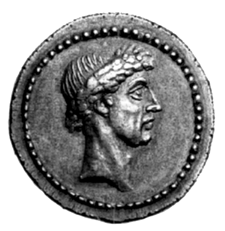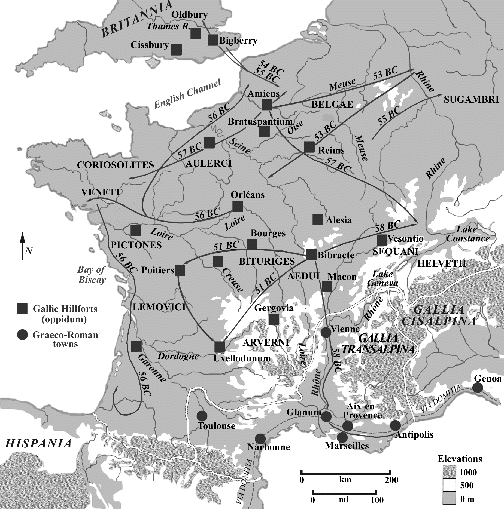|
Caesar's
Commentaries on the Gallic War (De Bellum Gallico) provide a uniquely
in-depth account of Gaul and its people. While cultural descriptions are secondary to military matters in Caesar's campaigns, the reader gains a familiarity
with settings, tribes, and personalities unavailable in Strabo,
Tacitus, or other ancient writers. Caesar's personal record of the
Gallic War included seven books on the campaigns from 58 to 52 BC,
ending with the defeat of Vercingetorix. An eighth book was later added
by Aulus Hirtius after Caesar's death, linking events of the Gallic War
to those of the Civil War (50-48 BC).Fig.1: Commemorative coin of Julius Caesar, Late Republican era, ca. 43 BC. are secondary to military matters in Caesar's campaigns, the reader gains a familiarity
with settings, tribes, and personalities unavailable in Strabo,
Tacitus, or other ancient writers. Caesar's personal record of the
Gallic War included seven books on the campaigns from 58 to 52 BC,
ending with the defeat of Vercingetorix. An eighth book was later added
by Aulus Hirtius after Caesar's death, linking events of the Gallic War
to those of the Civil War (50-48 BC).Fig.1: Commemorative coin of Julius Caesar, Late Republican era, ca. 43 BC.
Written
in an uncluttered, factual style, Caesar's Commentaries are much closer
to a memoir or historical outline than a formal history. Indispensible
as a source on the Gallic War, the work is also the only report by a
military commander of antiquity describing his own campaigns. In terms
of cultural reporting, Caesar's account is also invaluable, being the
only primary source on the Celts of Gaul, Germany and Britain during
the 1st century BC, and compares with Tacitus' accounts Germania and Agricola,
written a century and a half later (AD 98).
Caesar's life:
Cnaeus Julius Caesar was born about 100 BC into a patrician Roman
family, the Julii. Caesar's father was a brother-in-law of the Consul
Marius, victor of the Cimbro-Teutonic campaigns of 109-101 BC, and
later defeated by Sulla in 82 BC. Caesar's family ties with Marius
caused a brief exile at the
start of his military and political career. After several commands in
the east, Caesar won a quaestorship (financial office) in 69 BC, then
in 62 BC gained the office of Praetor and earned a triumph in
Spain. In 59 BC Caesar was elected to a consulship and given
command of Cisalpine Gaul and Illyricum for an unprecedented term of
five years. Upon the sudden death of the governor of Transalpine Gaul,
that province was quickly added to Caesar's command. Later, in 55 BC,
Caesar's tenure was extended for another five years, permitting long
military campaigns in Gaul.The Gallic War: As of about 60 BC,
Roman impact north of Provence had been relatively slight, consisting
mainly of trading relations along major rivers such as the Rhône and
Garonne. Bordering tribes such as the Helvetii, Sequani, Bituriges,
Aedui, and Arverni were minting their own Greek-inspired coinage
to facilitate trade with Rome, and had developed primitive state
systems with elected magistrates. The rest of Gaul, however, remained
on a pre-state level, and were among those termed "Barbarians" by the
Greeks and Romans.Caesar's campaigns in Gaul began in 58 BC,
when the Helvetii and several neighboring peoples began a mass
migration from their homes in Switzerland. Caesar forbade their passage
through Roman territory and marched against them. Once the Helvetii had
been driven back to their homes and their leader, Dumnorix, was
defeated, Caesar then turned on Ariovistus and his tribe, the Sequani,
who had been threatening the Aedui, allies of Rome. Ariovistus was
quickly defeated in a single battle. Thus began eight successive years
of largely successful campaigns that would secure the regions of Gaul
for Roman control.The following year, 57 BC, Caesar moved north
and conquered the Belgae. As they had been regarded the bravest of the
Gauls, Caesar had shown the strength of the Romans and his own
leadership skills in defeating them. This advance also served to drive
a wedge between the Germans and Central Gaul. Meanwhile, Caesar had
sent Crassus to subdue the northwestern tribes of Armorica (Normandy
and Brittany).Crossing
the Rhine and the Channel: Uncertain of Gallic loyalty in Armorica,
Caesar spent most of 56 BC there suppressing rebellious tribes. In
perhaps the most daring campaign of the Gallic War, Caesar crossed the
Rhine in 55 BC after defeating German tribes on its Gallic (western)
banks. He then thoroughly devastated the lands of the Sugambri. After
only 18 days in Germany, Caesar dramatically marched to the coast and
prepared a fleet for an invasion of Britain, the first of two landings
by Caesar. In August, late in the season, a force of two legions made
the Channel crossing to Dover. After being battered to near disaster by
tides, storms and hostile Celts, Caesar returned to Gaul just in time
to suppress a revolt among the Belgae.A major force of five
legions (half of the army in Gaul) was prepared for a second invasion
of Britain in July of 54 BC. After a successful landing, the Romans
marched as far as the Thames and secured tribute from several
British tribes, among them the Trinovantes under Cassivellaunus. Before
a permanent camp could be established in Britain, Caesar had to return
to Gaul in September, as the Belgae had convinced many Gallic tribes to
rebel. After a few skirmishes at the end of 54 BC, Caesar spent all of
53 BC subduing the resurgent Belgae and other rebellious tribes in the
north such as the Nervii, Menapii, and Treveri near the Rhine, as well
as the Senones and Carnutes.Vercingetorix: Gallic resistance
culminated in the following year (52 BC) under the Arverni warrior
Vercingetorix. Having begun in central Gaul, in the territory of the
Carnutes, rebellion quickly spread to the borders of Transalpina.
Caesar marched to secure his province in the south and  then
returned northwards against the rebellious tribes. After several small
sieges and battles, Vercingetorix and the Gauls were cornered and
besieged at the oppidum of Alésia. Though Caesar was ultimately victorious, the size of the relief
army shows that most of central and northern Gaul had risen in revolt,
including the Aedui who had traditionally been pro-Roman. After the
defeat of Vercingetorix, Gallic resistance would never again rise in
great force. Through 51 and 50 BC, Caesar was involved with
"mopping-up" efforts in Gaul, including a siege at Uxellodunum. then
returned northwards against the rebellious tribes. After several small
sieges and battles, Vercingetorix and the Gauls were cornered and
besieged at the oppidum of Alésia. Though Caesar was ultimately victorious, the size of the relief
army shows that most of central and northern Gaul had risen in revolt,
including the Aedui who had traditionally been pro-Roman. After the
defeat of Vercingetorix, Gallic resistance would never again rise in
great force. Through 51 and 50 BC, Caesar was involved with
"mopping-up" efforts in Gaul, including a siege at Uxellodunum.
Fig.2: map showing the campaigns of Caesar in Gaul, 58-50 BC.
Caesar's
Ethnography: During military descriptions, much of what Caesar says
about the Celts is generalized. Often, for example, even the Romanized
border tribes are characterized as if they were the more distant
barbarous tribes (Books 2-4). This probably served as propaganda to
justify Caesar's extending
his offensive more than strictly necessary to safeguard the Province,
and helped build support and funding for his large army for several years.
Yet Caesar's account also focuses specifically on the native cultures.
His most substantive description of the Celts comes in Book 6, where he
devotes ten chapters to the Gauls and eight to the Germans. He
specifies two basic classes among the Gallic Celts, the uppermost
consisting of Druids and Knights, and the lower made up of commoners.
The Knights or warrior elite were judged by the number of vassals they
maintained, with commoners said to live as slaves to the Druids and
Knights.
The Druids: As the learned priests of the Gauls, Druids
also served as judges and teachers. Caesar reports that the Gauls were
"extremely devoted to superstitious rites" and that many human
sacrifices were conducted, generally according with Strabo's accounts: "...they who are troubled
with unusually severe diseases, and they who are engaged in battles and
dangers... think that unless the life of a man be offered for the life
of a man, the mind of the immortal gods can not be rendered
propitious..." [BG 6.16].
Caesar paints one particularly vivid
picture of sacrifices involving wood frameworks, involving "...figures
of vast size, the limbs of which... they fill with living men, [when]
set on fire, the men perish... in the flames." [BG 6.16].
The Druids also took up to twenty years memorizing verses, not because
they lacked writing (since the Gauls used the Greek alphabet), but to
train their memories and because, in Caesar's view, " ...they did not
desire their doctrines divulged among the mass of the people. "[BG 6.14]
Mercury and other gods: Caesar also provides key information on Late Iron Age Gallic religion in Book 6 of his Commentaries,
including much of what is known about their gods. Foremost was a Celtic
equivalent of Mercury, Roman god of commerce: " ...they have many
images of him, and regard him as the inventor of all arts, they
consider him the guide of their journeys and marches, and believe him
to have great influence over... the acquisition of gain and mercantile
transactions." [BG 6.17]. Archaeological findings accord well with
Caesar's historic reference to the prevalence of Celtic images of
Mercury, which have been found in sites throughout France, Germany, and
Britain.
The Gauls also worshipped variant forms of Jupiter,
Apollo, Minerva, and Mars. They claimed descent from the god Dis (deity
of death and ruler of the underworld). As such, Caesar points out,
their calendar is based
on nights, rather than days, so that "...they keep birthdays and the
beginnings of months and years in such an order that the day follows the night." [BG 6.17]
Caesar
also reports in Book 6 (ch.21-28) on the Germans, whose customs
differed greatly from those of the Gauls. The Germans had no Druids and
paid little regard to sacrifices. Their gods consisted only of forces
that directly benefit them, "the sun, fire, and the moon." For Germans,
life was based on "...hunting and in the pursuits of the military art;
from childhood they devote themselves to fatigue and hardships. " [BG
6.21]
German social organization was largely informal, with
temporary warchiefs chosen only as needed. Their warlike, isolationist
tendencies distinguished them from the more civilized Gauls of Caesar's
day, although he notes that previously, the Gauls had been more warlike than the Germans.
Posidonius,
Strabo, Diodorus, Pliny, and Polybius: Other important sources on the
Gauls include Posidonius, a Stoic Greek philosopher and geographer
whose writings are now lost, but with whom Caesar may well have been
familiar. Posidonius' early 1st century BC comments on Celtic life in
Gaul influenced Strabo and Roman contemporaries of Caesar including
Diodorus Siculus (fl. ca. 44-40 BC). Other, still earlier source
material came from Polybius (200-118 BC) who wrote on the wars with
Hannibal and the Gaesatae Invasion, and who also (like Caesar) refers
to inhabitants of Gaul interchangeably as "Gauls" and "Celts."
Strabo (64 BC-AD 25), whose Geography, written ca. 20 BC, is the most complete of any retained from antiquity, devotes
all of Book 4 to Gaul. While parts are taken directly from Caesar, he
also provides considerable independent detail on the Narbonnaise,
Lyonnaise, Aquitania, and the Belgae, some derived from Posidonius.
Also using both Posidonius and Caesar was Pliny the Elder, who wrote a
history of the German War in ca. AD 60 (now lost).
.
|
|